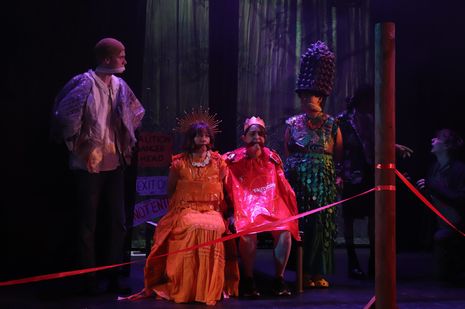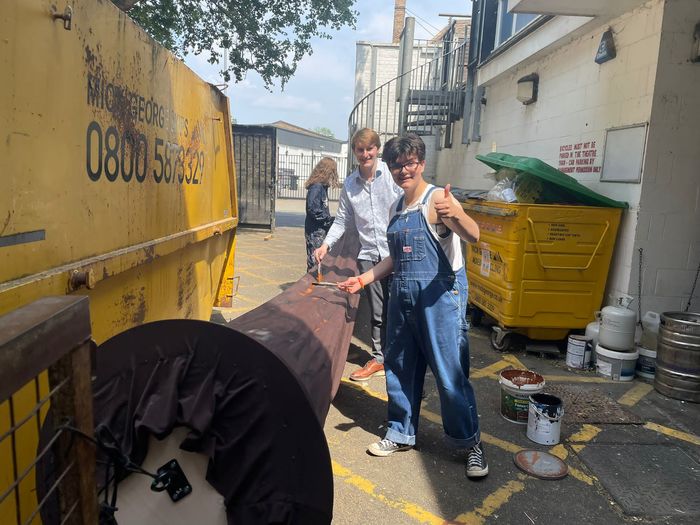Laughter amidst the wasteland in Mr Burns: A Post-Electric Play
Set in the midst of a nuclear apocalypse, Mr Burns finds humour in the horrifying

Mr Burns: A Post-Electric Play is a blisteringly frightening depiction of civilisation’s self-destruction, and the gnarled fruit that rises from its ashes. If that opening sentence reads as a tad mangled, that is only because this show is itself wonderfully mangled, mingled, and mashed together. Also, The Simpsons is in there somewhere.
The play opens with people huddling around a fire in the immediate wake of the apocalypse, trying to remember fragments of pop culture which we already know – or at least, this Simpsons fan does – and hitting huge stumbling blocks while doing so. The struggling, the stuttering, the brief moments of confoundment, are succeeded by euphoric moments of sudden recollection, the joke at last remembered. And the joke is vital. What is important isn’t just the joy of recollection, but the knowledge that something horrible lies out there beyond the light of the campfire. Terror, death, and tragedy are always peeking round the corner. In the opening section, a joke is stopped by the noise of someone approaching. Suddenly, our characters are hunched in terse silence, torchlights out and waiting. This whiplash movement between healing recollection and the sudden, arbitrary jolt of a violent world is the play’s engine.
“Terror, death, and tragedy are always peeking round the corner”
In the play’s opening two acts, the cast navigated these tonal jolts with real skill. One minute they’re sitting around a campfire, still remembering the small habits of past loved ones, and the next they’re bickering about creative decisions as they rehearse their play. When Tel Chiuri, as Gibson, struggles to remember an incident in the troupe’s past, everything that the play has been trying to keep out rushes in at once. The Noises Off-esque squabbling and bickering of the performers is pulled out from under us. Similarly, the manic mimicry of Joe Morgan as Matt is cut short by the fading of his memory. When Alice Roberts – playing the imperious Quincy – exclaims “meaningless entertainment is actually pretty hard,” we have been sharing this uphill struggle with them. There are some flat moments in this section where it feels like the actors are not fully unpacking the contours of the script. But these moments are easily forgiven when so much of the play’s difficult dialogue is performed with such ease. Directors Joshua Robey and Emma Gibson have extracted so much dynamic play from the material. Real, living breath has been lent to this decayed world.
Though cultural bricolage is very important to the play’s first two acts, it is in the third act where its electricity shines most brightly. Jessi Rogers’ and Sophie Campbell’s costumes were a deliciously hideous show of repurposed materials, with TK Maxx bags and Diet Coke cardboard recycled into the costuming of a Greek Tragedy. Think The Oresteia meets The Simpsons episode of Cape Feare, and you’re just about there. The set and props, designed by Rory Clarke, were also a perfect evocation of this world’s violence and precarity. Beyond the delightfully quaint Simpsons themed proscenium arch, there was a post-nuclear forest backdrop alive with warning signs. This whole section shredded everything from the first two acts and made a monument of it.
“Real, living breath has been lent to this decayed world”
The music of the play is a daring balancing act, with musical director Perrin Ford tying several discrete strands together into a tight, unyielding knot. In particular, the incidental music accompanying much of Mr Burns’ dialogue was nothing but sinuous sonic dread, twising, coiling, and yet never losing its way. There were various musical motifs – all drawn from different media, periods, and genres – all running at once. The strains of Funkadelic’s “One Nation Under a Groove” briefly bob up amidst the swirl of 8 Mile rap sections and Homer Simpson’s version of “Meet the Flinstones” from the Monorail episode. It could well have been a dog’s dinner, and not in a nice way. But, somehow, it was a triumph.
The performance of The Simpsons play itself, wherein the beloved family have become part of a broader consolatory mythos, was handled with such verve that even I began to weep and mourn. The final showdown between Theo Chen’s Mr Burns and Jessi Rogers’ Bart was not only loaded with mythic significance, but also had the audience in the palm of its four-fingered hand. By the time the play had concluded, no bows were needed. The show had done its job. Its story was told. It celebrated the power of memory and invention to reconstitute a culture that has been shot through the proverbial meat grinder by nuclear disaster. And what a celebration it was.
Mr Burns: A Post-Electric Play is playing at the ADC Theatre from Tuesday 13th to Saturday 17th of June.
 Interviews / You don’t need to peak at Cambridge, says Robin Harding31 December 2025
Interviews / You don’t need to peak at Cambridge, says Robin Harding31 December 2025 Comment / What happened to men at Cambridge?31 December 2025
Comment / What happened to men at Cambridge?31 December 2025 News / Unions protest handling of redundancies at Epidemiology Unit30 December 2025
News / Unions protest handling of redundancies at Epidemiology Unit30 December 2025 Features / ‘Treated like we’re incompetent’: ents officers on college micromanagement30 December 2025
Features / ‘Treated like we’re incompetent’: ents officers on college micromanagement30 December 2025 News / Varsity’s biggest stories of 202531 December 2025
News / Varsity’s biggest stories of 202531 December 2025










